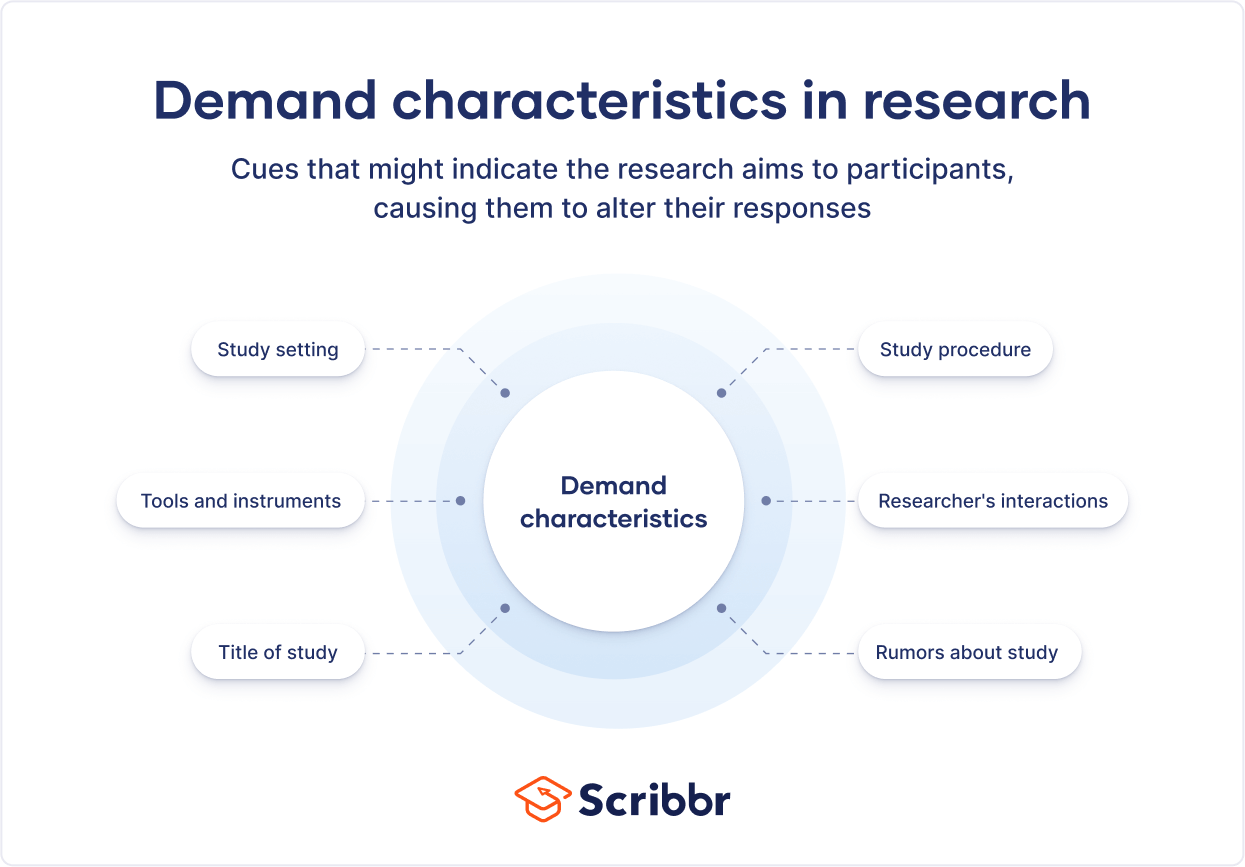Demand Characteristics | Definition, Examples, & Control
In research, demand characteristics are cues that might indicate the study aims to participants. These cues can lead participants to change their behaviors or responses based on what they think the research is about.
Demand characteristics are problematic because they can bias your research findings. They commonly occur in psychology experiments and social sciences studies because these involve human participants.
It’s important to consider potential demand characteristics in your research design and deal with them appropriately to obtain valid results.
What are demand characteristics?
Demand characteristics are extraneous variables that can affect the outcomes of the study. These cues may nudge participants to consciously or unconsciously change their responses.

Sources of demand characteristics
In psychology experiments, demand characteristics can arise from many sources. Think of these as clues about the research hypotheses.
These sources include
- Title of the study on recruitment materials
- Rumors about the study
- Researcher’s interactions with the participant (e.g., a smile or a frown after a response)
- Study procedure (e.g., the order of tasks)
- Study setting (e.g., laboratory environment)
- Tools and instruments (e.g., video cameras, skin conductance measures)
These study characteristics place hidden ‘demands’ on participants to respond in a particular way once they perceive them. They can be subtle or obvious.
You compare three different types of music with each other. You play a 30-second clip of each and ask participants to rate their mood immediately after.
Based on the order of the listening and mood-rating tasks, participants can figure out what this experiment is about and adjust their responses.
How do demand characteristics affect participants?
Based on your study materials or settings, participants might guess at the aim of the study, and their interpretations could influence their behaviors or responses.
The reason for this behavior change is simple: once you believe you know the aim of an experiment, it’s very hard to act as if you’re naive about it.
Sometimes, participants may actively play one of four roles.
| Role | Description |
|---|---|
| Good subject | The participant tries to be helpful and confirm the researcher’s hypothesis |
| Negative subject | The participant tries to act in ways that refute the researcher’s hypothesis—also called the ‘screw you’ effect |
| Apprehensive subject | The participant tries to produce the most socially desirable answers, out of fear of being judged |
| Faithful subject | The participant tries the act the way they would if they didn’t know the researcher’s hypothesis |
Participants who play the role of a good subject try to use what they’ve learned to help you with your research. Acting in this way gives some participants a sense of fulfilment.
Conversely, participants in a negative subject role may try to actively sabotage your study by acting in unexpected ways or lying in their responses.
You may find some participants taking on this role out of frustration with being told what to do. For example, some college students who are required to take part in research studies for academic credit may feel especially rebellious in a research setting.
Why do demand characteristics matter?
Demand characteristics can invalidate research studies by providing an alternative explanation for the results. They pose a threat to both internal and external validity.
When you have demand characteristics, the internal validity of your experiment isn’t secure. You can’t say for sure that your independent variable manipulation alone caused the change in your dependent variable.
Instead, your participants’ reactions to the demand characteristics may have led to the results.
But the participants’ responses may be distorted because of demand characteristics. Your measurements may not accurately reflect the results of your experimental manipulation.
Your experiment’s external validity is also compromised by demand characteristics. The presence of these cues may mean that your findings can’t be generalised to people or settings outside of your study.
It’s difficult to apply the findings from the laboratory to the real world because participants are primed to respond in a specific way in your experiment. These demand characteristics don’t always exist in the real world, so your findings may not be generalizable to other settings.
How do you control demand characteristics?
You can control demand characteristics by taking a few precautions in your research design and materials. These methods will help minimise the risk of demand characteristics affecting your study.
Use deception
You can use deception to hide the purpose of the study from participants. Deception can mean keeping some information from participants or actively misleading them about the study tasks, materials, or aims.
Ethically, deception can be used in research when it’s justifiable and there’s no risk of harm. You should always debrief participants about the study’s real aims after they’ve completed it.
Many psychology studies use filler tasks and cover stories to misdirect participants.
To make your cover story plausible, you add some filler memory tests for participants to complete. Participants begin by memorizing a list of words, and they list as many as they can recall between listening to the music and completing the mood ratings.
Use a between-groups design
In quantitative research, you usually use either a between- or a within-groups design. While participants receive only one independent variable treatment in a between-groups design, they receive all independent variable treatments in a within-groups design.
You are more likely to risk having demand characteristics if you use a within-groups design. Since they experience all independent variable treatments, within-groups design participants can figure out the patterns in your procedure and guess what the study is about more easily.
Use a double-blind design
When you use blinding or masking, you conceal from participants whether they are in a control or treatment group.
In a single-blind design, you know the participant’s condition assignment, while in a double-blind design, neither you nor the participants know the condition assignment.
You may have a greater risk of demand characteristics in a single-blind design compared to a double-blind design.
You expect participants in the treatment group to have more positive mood ratings. Because of your expectations, you are unintentionally friendlier with participants in the treatment group, giving them a more positive experience.
You repeat this study with a double-blind design. Since you don’t know which participant is in which group, you treat all participants the same way because you don’t have specific expectations about any of them.
Use implicit measurements
In psychology, implicit (hidden) measures help you record cognitive abilities, traits, or behaviors that people may not be open about or able to report. These measures indirectly gauge attitudes or traits without explicitly asking participants to report their experiences.
Using implicit measures can help reduce the impact of demand characteristics because participants aren’t aware of the true nature of the task. These measures can also help you mislead them from the real aim of your study.
Based on previous studies, you use a word completion task to infer participants’ moods. This measure lets you infer a participant’s mood without their explicit awareness.
Your participants believe this task is about their cognitive abilities, whereas it actually measures their moods indirectly.
Other types of research bias
Frequently asked questions about demand characteristics
Cite this Scribbr article
If you want to cite this source, you can copy and paste the citation or click the ‘Cite this Scribbr article’ button to automatically add the citation to our free Reference Generator.
Bhandari, P. (2023, March 13). Demand Characteristics | Definition, Examples, & Control. Scribbr. Retrieved 3 April 2025, from https://www.scribbr.co.uk/bias-in-research/demand-characteristics-explained/
